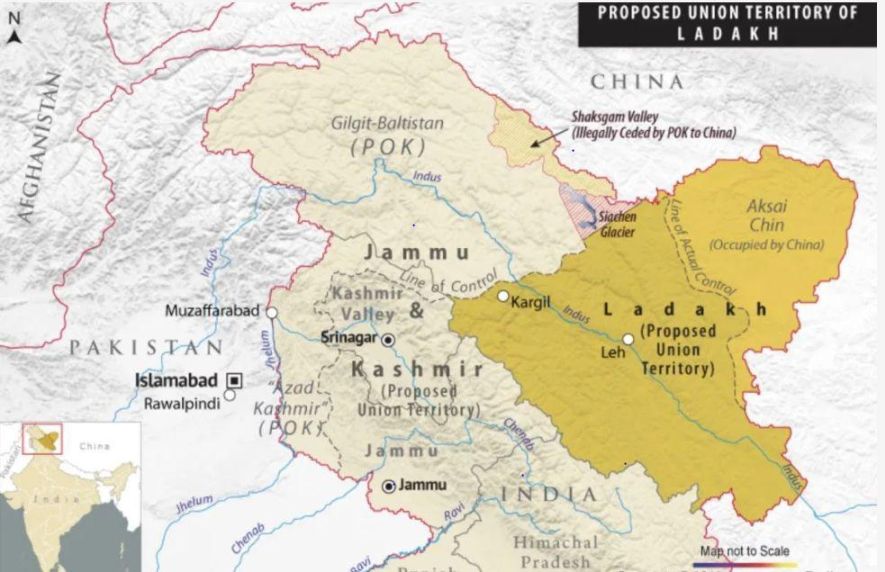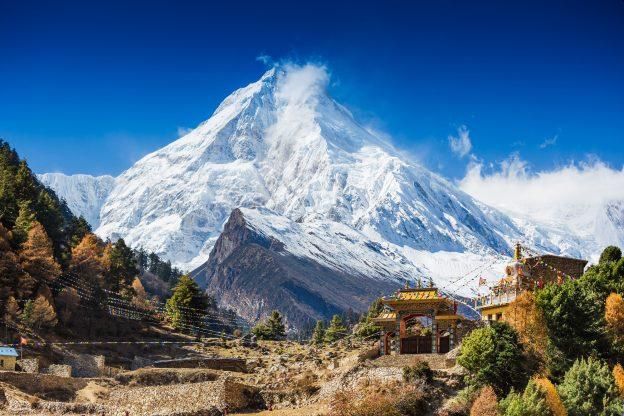By Eric Vandenbroeck and co-workers
The Climate Crisis in Tibet
We have followed the
Himalayan region including its political dispute, for example in a three-part article here. However, there also has been the
development of a serious climate crisis which we will address here.
In recent years,
China’s territorial aggression in the Himalayas, including in the Tibetan
Plateau, has been growing. China’s strategy has focused mainly on using the
continental version of the well-known “salami tactics” on neighbors like India
and Bhutan. Notably, Tibet is a major source of insecurity for the Chinese
ruling regime, namely the Communist Party of China (CPC). In Tibet, apart from
the build-up of the people’s Liberation Army (PLA) and its activities to pursue
Tibetan repression in the restive provinces, the CPC’s stress is also on
accelerating infrastructure development, from building mega-dams to mining
activities.
In this context,
China has been constructing dams on rivers originating in Tibet such as the Yarlung Tsangpo (called the
Brahmaputra River in India) for hydroelectricity generation and irrigation
purposes. As per reports, China has built thousands of dams (more than 87,000)
over the years. Moreover, China’s Ministry of Water Resources has accelerated
the construction of reservoirs, dikes, and detention basins, with the capacity
of the country’s reservoirs being increased by 163 billion cubic meters.
Naturally, as a
number of rivers originate in Tibet and as most are often trans-boundary rivers
(Brahmaputra; Mekong; and Salween, the second-longest river in Southeast Asia
after the Mekong where thus far no dams, have been completed] to name a few),
the environmental impact will be borne heavily by Tibet and the lower riparian
countries like India, Bangladesh, Laos, Myanmar, and Vietnam. One of the CPC’s
strategies to control access to water for China “hydro-hegemony” purposes.
The repercussions are
already beginning to show: In Southeast Asia, farmers and fishers across the
Mekong River region experienced debilitating droughts in 2020 itself. Research
has shown that this was directly due to Chinese engineers actively working to
limit the river’s flow. Notably, China’s over-damming of Tibetan rivers has
been pursued under a faulty assumption of the seismic potential on the Tibetan
Plateau. Increased seismic activity could impact the
structural integrity of the dams, further threatening the geological
equilibrium and potentially causing damage to cultural heritage sites built
along the rivers.
Be it the planned
construction of the Kamtok (Gangtuo) dam in the
sacred Tibetan mountains – one of the many dams proposed along the upper
reaches of the Drichu (Yangtze) river – or reports
about a new dam on the Mabja Zangbo
River (which flows into Nepal’s Ghaghara or Karnali before joining the Ganges
in India) in Tibet’s Burang county, bordering Nepal
and India, the Chinese strategy to control Tibetan resources and divert waters
for its own insatiable energy and other requirements will wreak havoc on the whole
Himalayan region, and beyond.
Although
international forums and research organizations such as the United Nations
Framework Convention on Climate Change (UNFCCC), the Intergovernmental Panel on
Climate Change (IPCC), and the Nepal-based International Centre for Integrated
Mountain Development (ICIMOD have already highlighted the impact of unfettered
and large-scale hydropower development on ecological concerns, precious little
has been achieved. Given the urgency of global warming and the melting of the
Third Pole in particular, such hydropower investments need to be examined.

The Tibetan Plateau –
Asia’s water tower and China’s major source of critical minerals like copper
and lithium – is facing severe ecological degradation due to China’s extensive
infrastructure projects, including mega-dam building, forced relocation of Tibetans,
and mining. The increase in the so-called development projects such as the 2006
Golmud-Lhasa railway link among other such
initiatives via China’s “Western Development Strategy,” or the “Go west” policy
have only facilitated greater exploitation of Tibet’s natural reserves
including critical minerals.
Although, on paper
China has referred to its development strategy in Tibet – which it has now
renamed as “Xizang” to scuttle the region’s identity further – as a tool to
provide economic reforms in the western provinces, at par to the high-quality
development in other well-to-do parts. However, rather than reducing poverty,
industrial development and other such activities are wreaking havoc on the
already accelerated rate of climate change in the region, which is threatening
not only the water security of downstream nations like India and Bangladesh but
also Tibet’s own biodiversity and entire Himalayan ecosystem.
Systematic and
large-scale mining of minerals in Tibet began decades ago soon after China’s
annexation of Tibet, which has significant reserves of the world’s deposits of
uranium, chromite, boron, lithium, borax, iron and graphite. Due to the push
for green transition and high-tech manufacturing, there is a high global and
domestic demand for critical minerals such as lithium and rare earths. As a
result, China – which is one of the major countries for supplying rare-earth
raw materials and is also an importer of critical minerals for its dominant
refining/processing industry accounting for approximately 60% of worldwide
production and 85% of processing capacity – is looking to consolidate its lead
by exploiting Tibet.

Activists have also
raised concerns about China’s illegal sand and gravel mining from riverbeds
(e.g., in Tsaruma village, the source of the Yangtze
and the Yellow Rivers) for use in construction and other human activities. This
impacts biodiversity, soil erosion, river flows, pollution, destruction of
farmlands, and in turn, extreme events. Research has also revealed that high
arsenic content in the water and soils in Tibet, in part being attributable to
the mining operations.
Unfortunately,
China’s large-scale extraction is happening at fast rate and using unethical
measures. The Chinese government also uses a heavy hand against any protests by
the Tibetan residents, which impedes any constructive action. So although the United Nations Environment Programme (UNEP) has called for urgent action to avoid a
“sand crisis,” Tibet-specific calls-for-action are hard to find.
In addition, for many
years now, China has also been mining Tibet’s fresh water
resources as a “new sustainable” economic growth pillar. This has no doubt
boosted China’s bottled water industry but is disastrous for the Tibetan
ecosystem, as in the longer term it help rivers to dry
up faster. In tandem with the over-damming and mining of critical minerals, the
ramifications are unfathomable.
For example, it has
been widely reported that the Tibetan Plateau has been warming more than three
times faster than the global average, with Tibet’s permafrost thawing faster.
Moreover, infrastructure activities particularly mining in sensitive regions that
cause disturbance and pollution have a direct correlation with glacial retreat
that has accelerated in the last decade due to human activities like mining,
burning fossil fuels, and deforestation. Glacial retreat refers to the
shrinking of glaciers, which is a recent phenomenon and a major marker of
climate change.
Although the
Intergovernmental Panel on Climate Change (IPCC), the UN body for assessing the
science related to climate change, has been highlighting these aspects in the
high mountains of Asia in its reports, the Chinese government’s actions in
Tibet have only grown in scope.
The broader Himalaya
region, which includes the Tibetan Plateau, is a global
biodiversity hotspot and
has the largest reservoir of freshwater outside the two Arctic and Antarctica
polar regions, among other important features. In view of the dangers of a
Himalayan meltdown, the meeting – hosted by Bhutan’s Prime Minister Tshering
Tobgay – vehemently expressed the need for “coordination and support” at global
forums to “represent and amplify” regional concerns that have global
implications.
However, two factors
highlight the complications and even the inadequacy of holding vital meetings
in such an almost incidental manner: One is the general declining trust in
multilateral climate conferences amid low political will. This year it was
particularly apparent because of the lack of
attendance of
the heads of state of major powers and some of the biggest carbon emitters,
including Brazilian President Luiz Inacio Lula da Silva, Chinese President Xi
Jinping, Indian Prime Minister Narendra Modi, German Chancellor Olaf Scholz,
and outgoing U.S. President Joe Biden.
In addition, the
election of Donald Trump – a well-known climate change
skeptic who withdrew the United States from the Paris Climate Accord
during his first term – as the next U.S. president has undone any hope there
was left in securing international climate solidarity. And that’s not to
mention the inherent ethical dilemmas of having two big, influential oil
producers hosting back-to-back COP summits (the UAE in 2023 and Azerbaijan in
2024). It highlights that countries with clout – including China, which
continues to “elevate its
position” at the U.N. bodies
– have dominated the global climate forums.
The second problem is
the absence of core Himalayan issues in the main UNFCCC agenda, which is governed not just by financial intricacies and
inconveniences but unfortunately by “the very worst
of political opportunism,”
as the Marshall Islands’ climate envoy put it. In particular, the acute
marginalization of Tibetan representation in these multilateral climate forums,
where China reigns
supreme, has only hampered regional
concerns from being truly voiced, let alone amplified.
Against such a
scenario, what more can the multilateral forums do? How should the global community
– including India – respond to China’s apathy for the climate crisis in Tibet?
The COP29 Upside: 11th Hour Consensus as the Sole
Face-Saver?
COP29 was dubbed the
“climate
finance COP,”
formally known as the New Collective Quantified Goal on Climate Finance (NCQG).
After two weeks of intensive negotiations and several years of preparatory
work, the new financial goal is a “course correction” on global climate action.
It has tripled the finance to developing countries,
from the previous goal of $100 billion annually announced in 2009 to
$300 billion a year by 2035. COP29 also pledged to continue efforts to
harness all actors from public and private sources to scale up
finance to developing
countries to $1.3 trillion per year. The climate framework intends to
cover all greenhouse gases and all sectors to keep the 1.5 degrees Celsius
warming limit within reach.
The new commitment
builds on significant strides forward in global climate action at COP27 and
COP28. A historic Loss
and Damage Fund was
agreed upon at COP27, while COP28 delivered a global agreement to transition
away from all fossil fuels in
energy systems, triple renewable energy, and boost climate resilience.
An agreement on
carbon markets is another significant step. The final building blocks that set
out how carbon markets will operate under the Paris
Agreement Crediting Mechanism have been agreed upon. This includes the
standards for a centralized carbon market under the U.N. (Article 6.4
mechanism) to operationalize country-to-country
trading and a carbon
crediting mechanism. It entails clarity on how countries will authorize the
trade of carbon credits and how registries tracking this will operate.
Furthermore,
the transparent
process of technical
reviews would ensure environmental integrity. This includes mandatory
checks for projects
against strong environmental and human rights protections. It ensures that a
project cannot proceed without explicit, informed agreement from Indigenous
peoples. It also allows anyone affected by a project to appeal a
decision or file a complaint. This will benefit developing countries receiving
new flows of finance and the least developed countries by providing
capacity-building support to get a foothold in the market.
In terms of concrete
steps aimed at the Himalayan ecosystem, there were a few high-level plenary
sessions at COP29 such as the “Resource
Mobilization for Climate Adaptation in Asia’s High Mountains,” which stressed the “urgent need for increased
investment in climate adaptation” in this region. These seem mostly
ineffectual, in-name-only steps. In contrast, the launch of
G-ZERO – a forum of
carbon-negative and carbon-neutral small countries, which prominently includes
Bhutan (also its permanent secretariat) – at COP29 is truly inspirational. Such
actions that aim to “enhance carbon sinks and promote nature-positive pathways”
will go a long way to build a positive ideology needed to counter climate
change in the Himalayas.
As far as Tibet’s
participation in COP29 goes, the two Tibetan
delegates – Dechen Palmo
and Dhondup Wangmo – raised environmental concerns at some events. They even
launched a campaign to raise awareness about the risks posed by hydropower
projects in China, particularly the Derge Dam – a hugely controversial project
that had resulted in mass protests and a brutal crackdown by the
Chinese government earlier this year. Yet the token participation of two
Tibetans in a few events at the sidelines of the summit is clearly not enough.
The fact of the
matter is that despite the adoption of the “Baku Workplan,” which took a decisive step forward to elevate the
voices of Indigenous peoples and local communities in climate action, neither
the Hindu Kush Himalaya region nor its peoples, including Tibetans, have been
included in the mainstream discussion and, more importantly, in policymaking on
climate change.
China’s Tibet Apathy: Accelerating Regional Climate
Risks
That climate change
is wreaking havoc in the Tibetan Plateau is old news: For years, it has been established that global
warming is not only causing Tibet’s glaciers to melt and permafrost to thaw at
an alarming rate but also accelerating several extreme weather events such as
flash floods. In 2019, a special report by the Intergovernmental Panel on Climate Change
(IPCC) warned that up to two-thirds of the region’s glaciers would disappear by
the end of the century if carbon emissions were not cut drastically.

On top of the
challenges due to global warming, China’s so-called “unprecedented” development policies have hastened Tibet’s climate
crisis. China’s relentless pursuit of infrastructure, including helipads,
rails, and road networks, as well as dual-use military facilities is causing
environmental degradation. That’s on top of the human costs that come with the displacement of nomadic and
farming communities due to the (over)damming and diversion of Tibet’s
rivers.
China’s Tibet policy
is driven by its need to fill the demands of Han-majority regions, including
access to Tibet’s water or mineral resources (reportedly also including rare earths). It also has a larger securitization angle: building
excessive military
infrastructure to
not only clamp down on all separatist activities but also create conditions for
a heavily militarized border, particularly against India. China’s increasing
militarization in Himalayan
territories and
influence in countries such as Pakistan and Nepal also have repercussions for
the instability of the South Asian region as a whole.
China is also using
its control over Tibet’s water resources to slowly develop into a water
hegemon. Ten major rivers, from the Mekong to the Yarlung
Tsampo (Brahmaputra in India) originate in Tibet, and
China is planning or has already executed major dams on a number of these
rivers. Beyond the impact on Tibet’s people and environment, such actions have
given rise to concerns about China’s intent to block access to water to
downstream countries.
This has heated up
the already tense geopolitical climate in South and Southeast Asia. China stands
accused of using
financial incentives as well as economic coercion to clamp down either dissent
or disagreement over China’s “core national interests,” as well as to fulfill
its various strategic goals.
The Imperative for Climate Solidarity: Beyond
Multilateral Unity?
Undoubtedly, the
future of Asia’s high mountains depends on the decisions of the global climate
bodies and the collective efforts taken to build climate-resilient communities
and protect these vital ecosystems. A unified effort to combat these challenges
would mean moving beyond the business-as-usual approach and focusing on
targeted investments and mobilization of international support. There is a need
to quantify economic costs for loss and damage to the specific ecosystem to
drive new investments and support stronger policy coordination.
In the Himalayan
region, as raised by the Himalayan ministers’ council at COP29, tackling
transboundary issues with a common approach has to be
given the spotlight. Some of these issues include but are not limited to
cryosphere risk monitoring, disaster preparedness, increasing air pollution,
biodiversity conservation, and innovative financing solutions.
Support
at global forums like the U.N. climate conferences to represent and
amplify common issues and concerns is critical in attracting global attention
to the Himalayan region. This would hopefully also allow access to global
funds, such as the Global
Environment Facility, which
is a partnership of 18 agencies (including United Nations agencies,
multilateral development banks, national entities, and international
NGOs) and U.N. financial
mechanisms such
as the Adaptation Fund and Green Climate Fund (GCF), as well as other potential
innovative financing solutions. Such an imperative will go a long way to
fulfill the funding need that was highlighted by Bhutan’s Secretary of the Ministry of Energy
and Natural Resources Karma Tshering at COP29
Moreover, the
multilateral partnership must prioritize the Himalayan climate crisis in their
common agenda. Four years earlier, at the height of the COVID-19 pandemic,
the 2020
Ministerial Mountain Summit had
declared some common goals, including holding a biennial summit for the eight Hindu
Kush Himalaya countries and creating a task force to monitor and assess the
calls for action. This needs to be taken forward with renewed momentum at the
COP30 to be held in Brazil.
While multilateral cooperation is a must, there is
also a need to amplify the voices of the marginalized and suppressed
communities in the high mountains. Particularly, the Tibetan Plateau and its
people need the international community, including India and the West, to check
China’s growing inroads into the Tibetan landscape. Be it China’s excessive
damming of Tibetan rivers, mining, or construction of dual-use military
infrastructure (e.g., roads and helipads), China’s actions in Tibet belie its
claims of adhering to the United Nations’ Sustainable Development Goals. Then
there are also the human rights aspects of the Tibetan occupation, which also
lends to the climate change acceleration as the original settlers are “relocated.” In this context, India and the West need to
collaborate to bring the Himalayan concerns into the emerging Indo-Pacific
regional architecture agenda. A common security agenda might help consolidate
climate action.
For updates click hompage here